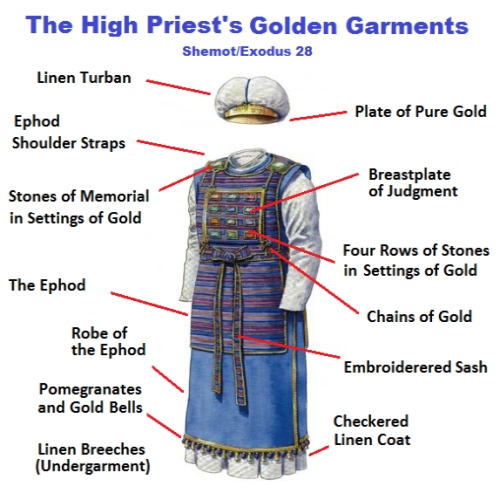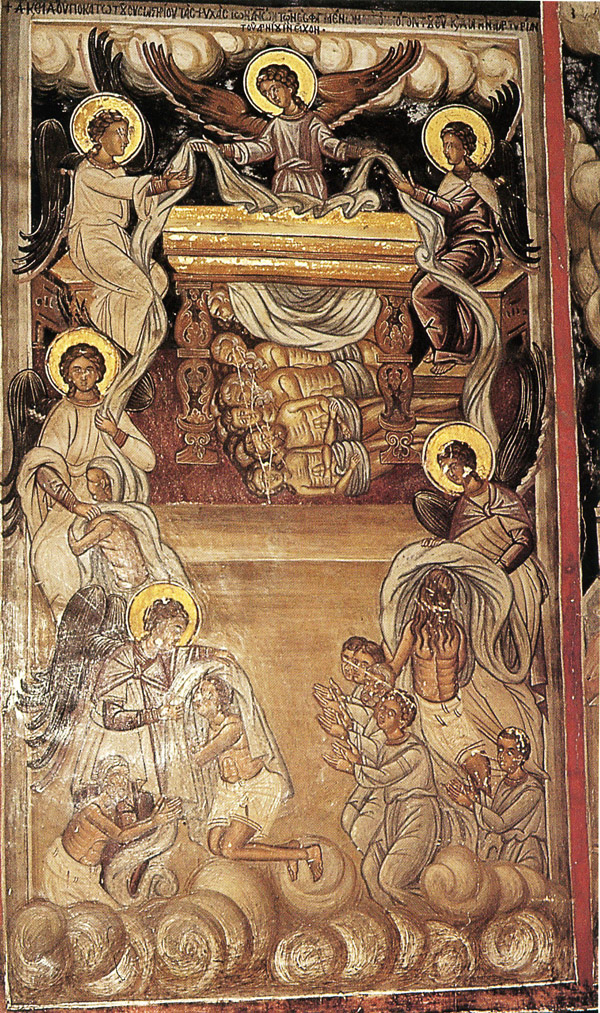This article respectfully explores the history, changes, and current beliefs and practices about sacred Mormon temple garments: The sacred, special underwear worn by members of the Church of Jesus Christ of latter-day saints.
What are “Mormon Underwear?”
“Mormon temple garments” are a type of religious undergarment worn by some faithful members of the Church of Jesus Christ of Latter-day Saints. The garments are worn by members who have participated in the temple endowment ceremony, a sacred ordinance in the Church of Jesus Christ.
Temple garments are underwear designed to be worn under regular clothing. They are white (except for special colored versions worn by the military,) and look like a regular t-shirt and shorts. They are meant to be a reminder of the covenants made in the temple. The garment includes a top and bottom for both men and women, with different styles and fabrics available for men and women.
The garment is often referred to as a “shield and a protection” by members of the LDS Church, and is believed to provide spiritual protection to the wearer. The garment is considered sacred by members of the church and is not meant to be visible to others.
While not all members of the LDS Church wear temple garments, those who do consider them to be an important symbol of their faith.
Outside of the Church, LDS garments are sometimes called “magic Mormon underwear,” “Mormon undergarments,” or “Mormon temple garment.” Words like some of these used to denigrate and mock can be offensive and hurtful to members. Church members refer to these underclothes as the “garment,” the “sacred temple garment,” or the “garment of the Holy Priesthood.”
Members of the Church have a strong reverence for the temple garment and refer to it as a “garment,” a “sacred temple garment,” or the “garment of the Holy Priesthood.” They typically don’t discuss the temple garment not because it is a secret, but because it is holy to them. This garment is a reminder of the promises they have made to God and serves as a reminder of the blessings that can be received if they remain true to their commitments.
What Are Temple Garments?
Temple Initiatory: Clothing in the Temple Garment
What is the Temple Garment and is it Magic?

Fig Leaves
Fig leaves, the first clothing mentioned in the Bible, are useful for medicine and for the Hebrews were a symbol of peace. After they realized they were naked, Adam and Eve “sewed fig leaves together and made themselves aprons” and then “did the Lord God make coats of skins, and clothed them.” (Genesis 3:3, 27).
Ancient History of Sacred Temple Clothing
Clothing, both ancient and modern, has often represented of people’s commitment to God. Examples include the Catholic nun’s habit or priest’s skullcap, Jewish prayer shawl, the Muslim Turban or Hijab. Similarly, the temple garment is a reminder of faith in God for members of the Church of Jesus Christ of Latter-day Saints.
Biblical Origins
In the garden of Eden, Adam and Eve “were both naked, the man and his wife, and were not ashamed” (Genesis 2:25). But after taking of the fruit, “the eyes of them both were opened, and they knew that they were naked; and they sewed fig leaves together, and made themselves aprons” (Genesis 3:7).
After the consequence of partaking of the fruit of knowledge, God expelled them from the garden. He also gave them new clothing to replace the fig leaves: “Unto Adam also and to his wife did the Lord God make coats of skins, and clothed them” (Genesis 3:21).
In ancient jewish tradition, these coats made by God for Adam were considered sacred and significant. They were passed down and preserved with Noah through the flood, until they finally gave Nimrod power over the beasts. (Pirkei de-Rabbi Eliezer (ch. 24) )
Much later, when the Lord and Moses brought Israel out of Egypt, He also explained that their clothes could remind them of the commandments (Numbers 15:37-41). For Aaron and his sons, Moses was commanded to “make holy garments . . . for glory and for beauty . . . that [they] may minister unto me” (Exodus 28:2-3).
In connection with Moses’ ancient tabernacle, clothing was an important symbolic part of worship with detailed instructions for priestly garments. Helpful definitions for some of these items, such as ephod, mitre, and girdle, unfamiliar to modern readers are given in the glossary.

Aaron’s Holy Garments
Exodus gives detailed instructions on the symbolic clothing of Aaron and the priests of the tabernacle.

White Robes as Symbols
White clothing has long been symbolic of purity and being cleansed from sin.
In this 1650s painting from the monasteries of Dionysiou and Dochiariou on Mount Athos in Greece, souls are receive white robes as they enter heaven.
Modern history of garments in the Church of Jesus Christ
Joseph Smith introduced garments in 1844 by revelation from God as part of the endowment ceremony in the temple in Nauvoo, Illinois. Garments were usually made by members at home from white, unbleached cotton.
Over the years, the design and materials of the garments have evolved. Early garments were long, extending to the wrists and ankles. They were often made at home by the wearer using patterns recommended by the church. In the early 20th century, garments were shortened to include short sleaves and shorter legs. By the mid-20th century, design options included a two-piece garment, with a separate top and bottom.
Since the 1970s, the church has continued to modify the design of the garments to make them more comfortable and practical for everyday wear. Various styles, fabrics, and fits have been introduced, including different sleeve lengths and necklines for women, as well as moisture-wicking and antimicrobial materials. The church has also made efforts to accommodate the needs of members with various body types, medical conditions, and cultural considerations, or serving in the military.
The sacred clothing of Latter-day Saint temples
Sacred Temple Clothing | Latter-day Saint Temple Robes and Garments
Current practices
Today, LDS temple garments are available in a variety of styles and materials to suit individual preferences and needs. Members who have received their endowment continue to wear the garments as a reminder of their covenants and commitments to God. The garments are considered sacred, and members are taught to treat them with respect and care.
“Many faithful Latter-day Saints wear a garment under their clothing that has deep religious significance. Similar in design to ordinary modest underclothing, it comes in two pieces and is usually referred to as the ‘temple garment.’ … To Church members, the modest temple garment, worn under normal clothing, along with the symbolic vestments worn during temple worship, represent the sacred and personal aspect of their relationship with God and their commitment to live good, honorable lives.”
“The simple vestments combine religious symbolism with echoes of antiquity reflected in ancient writings from the book of Exodus.” Read More at Sacred Temple Clothing
Frequently Asked Questions:
Are garments magical or mystical?
The idea that Mormons wear garments day and night for magical physical protection may originate in 1844. Joseph and Hyrum Smith were murdered at Carthage jail without their garments on. Willard Richards and John Taylor also accompanied them, but survived. Taylor recovered from numerous bullet wounds, but Richards was wearing garments and escaped with minor bruises. One bruise came from a bullet hitting and stopping in a stopwatch in his chest pocket.
Joseph and Hyrum removed their garments before voluntarily surrendering in Carthage because they were concerned they would be killed and didn’t want the sacred clothing to end up in the hands of their enemies.
Some incorrectly assumed that Richard’s survival was a result of his wearing the garment and that garments promise physical safety.
Several more recent church leaders have clarified that according to the official temple ceremony, the garment provides a spiritual, a “magical” physical protection.
“The First Presidency of the LDS Church has explained that the temple garment serves as “a protection against temptation and evil” and instead of it being some type of ‘lucky talisman’ the “promise of protection [associated with it] is conditioned upon worthiness and faithfulness.” (First Presidency Letter, 10 October 1988; see Ensign, August 1997, 19-).
Do all Latter-day Saints have to wear garments?
No. Only those who have gone through the temple Endowment ordinance are encouraged to wear them throughout their lives. Members who have completed the temple ceremony prefer to wear the garments as often as reasonable to remind them of their relationship with God.
Do Latter-day Saints wear garments at all times?
Obviously not all the time. Members strive to wear them when possible and practical as a reminder of their covenants with God. They remove them when wearing garments might expose the sacred clothing to ridicule or mocking. Common activities such as swimming, showering, competing in athletic events, military activities.
One temple recommend question historically deviated from the endowment ceremony by asking if members wear the garment “day and night.” This question has now been updated to align with the ceremony, which simply instructs to participants to “wear throughout your life.”
“Do you keep the covenants that you made in the temple, including wearing the temple garment as instructed in the endowment?”
President Russell M. Nelson explained it this way:
“Wearing the temple garment has deep symbolic significance. It represents a continuing commitment. Just as the Savior exemplified the need to endure to the end, we wear the garment faithfully as part of the enduring armor of God. Thus we demonstrate our faith in Him and in His eternal covenants with us.”
Personal Preparation for Temple Blessings, April 2001 general conference
Temple Garment Resources
What are temple garments: video
What Is the Mormon Temple Garment (and is it magic)? Youtube: https://youtu.be/uGQjH-SKvlU
Scripture References
Church Leader Messages
The Temple Garment: “An Outward Expression of an Inward Commitment”, Elder Carlos E. Asay
Oil in Our Lamps, Elder Lynn G. Robbins
Modesty: A Timeless Principle for All, Silvia H. Allred
Worthy of Our Promised Blessings, Linda S. Reeves
Articles
Preparing to Enter the Holy Temple
“Missionary Conduct,” Missionary Handbook
“Obtaining Church Materials and Locating Information on Family History,” Family Guidebook
“Self Reliance: How I Prepared for the Temple,” Mormon Channel
“New Sizing for Women’s Garments,” Ensign, September 2015
“People sometimes ask me about the temple garments, occasionally in disrespectful terms. What should I say to them?” Liahona, September 2012
“Understanding Our Covenants with God,” Ensign, July 2012
“Mom’s Commitment to Modesty,” Ensign, June 2011
“Why Symbols?” Ensign, February 2007
“The Most Important Step,” New Era, June 2000
“Preparing for Your Temple Endowment,” Liahona, August 1988
In the News
“Church Produces Video on Sacred Nature and Purpose of Temple Garments,” Church News
“Temple Garments,” Newsroom
“Temples,” Newsroom
“Frequently Asked Questions,” Newsroom
Summary
“Mormon Underwear”, or LDS temple garments, are typical of a wide variety of religious clothing that many enjoy. Worn by members of the Church of Jesus Christ of Latter-day Saints, this reminds wearers of their covenant relationship with God. Those covenants include loving and serving others, remembering Jesus Christ, and committing to honor marriage and family.
Church of JEsus Christ
About Modern Temples